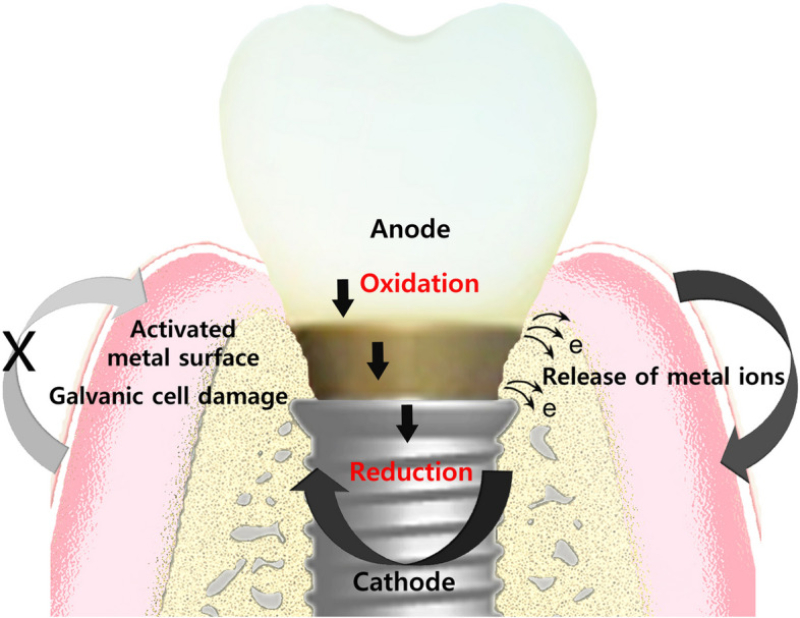Introduction to Oral Galvanism
Oral galvanism refers to a condition where small electric currents are generated inside the mouth due to the presence of different metals. These metals, found in dental implants and other dental materials like fillings or crowns, can interact with each other and saliva, creating an electric current. This phenomenon has yet to be well known by the general public. Still, dental professionals have studied it to understand its effects, especially in patients with metal implants like titanium.
What is Oral Galvanism?
Oral galvanism occurs when different metals in the mouth, such as titanium, gold, copper, mercury, or metal alloys, interact with saliva and produce an electric current. This process resembles a battery, where different materials exchange electrons and create electricity. In the case of oral galvanism, electricity is not decisive, but it can still cause discomfort or other symptoms in some individuals.
How Do Dental Implants Cause Oral Galvanism?
Many dental implants, including titanium implants, are made of metals or metal alloys. When these metals come into contact with saliva, a good conductor of electricity, it creates the potential for galvanic currents. The implant fixture (the part that connects to the bone), often made of titanium, may have a different electron charge than the metals used in crowns (the visible part of the implant), such as chrome or nickel. The difference in electric potential between these metals can cause a small electric current to flow through the mouth.

Image source:https://pubmed.ncbi.nlm.nih.gov/37801180/
Symptoms of Oral Galvanism
Oral galvanism can cause various symptoms, though they are not always easy to identify. Some common signs of oral galvanism include:
- Metallic taste: People with oral galvanism often report a metallic taste in their mouth, which can be due to the presence of different metals and the current generated between them.
- Tingling or burning sensation: Some patients experience tingling or burning sensations in their mouth or tongue caused by the low electricity flow in the area.
- Increased saliva production: Salivation may increase as the body reacts to metal in the mouth, further encouraging the generation of electric current.
- Headaches or facial pain: People sometimes report headaches or pain in the face or jaw. This could be linked to the electrical disturbances caused by the metals.
- Other sensory disturbances: Some individuals may feel sensitivity to touch or temperature, which can be linked to the electrical activity caused by the galvanic reaction.
Diagnosing Oral Galvanism
Diagnosing oral galvanism can be tricky because the symptoms may overlap with other conditions. However, dentists use several methods to test for the presence of galvanic currents in the mouth:
- Electrical Testing: Dentists can use special instruments to measure the electric current between metals in the mouth. If a significant current is found, it could suggest the presence of oral galvanism.
- Medical History: Dentists also take a thorough medical history to rule out other potential causes for the symptoms.
- Elimination Method: In some cases, the dentist may replace or remove metal restorations (such as crowns or fillings) to see if the symptoms improve, indicating that galvanism is likely the cause.
Galvanic Corrosion in Dental Implants
A primary concern related to oral galvanism is the potential for galvanic corrosion. This occurs when two metals in a moist environment, such as the mouth, begin to rust or break down. When metals corrode, it can weaken dental implants or other metal restorations. In the worst-case scenario, this could lead to the need to replace the dental work or cause discomfort due to the breakdown of the materials.
Oral Galvanism and Precancerous Lesions
One of the more concerning issues related to oral galvanism is its possible link to oral precancerous lesions. Research has suggested that the electric currents generated in the mouth could contribute to cellular changes in the surrounding tissues. While this is still an area of ongoing study, some scientists believe that constant exposure to low-level electricity could increase the risk of developing oral cancer, especially when combined with other risk factors such as smoking or excessive alcohol consumption.
How Can Oral Galvanism Be Managed?
Managing oral galvanism usually involves reducing the number of different metals in the mouth. Dentists may suggest replacing metal fillings or crowns with materials that do not conduct electricity, such as ceramics or composite resins. Additionally, they may recommend using metals that are less likely to cause a galvanic reaction with each other, such as replacing older mercury amalgam fillings with newer materials.
For patients with dental implants, particularly titanium implants, the dentist may need to monitor any symptoms closely and replace any adjacent metal dental work contributing to the galvanic reaction. Dentists sometimes suggest switching to all-ceramic crowns or other non-metallic alternatives to reduce the risk of oral galvanism.
What Can Patients Do to Prevent Oral Galvanism?
Patients can take several steps to minimize their risk of developing oral galvanism. These include:
- Regular Dental Checkups: Seeing a dentist regularly ensures that any potential issues with metal restorations are detected early and can be addressed before they become problematic.
- Choosing Biocompatible Materials: When doing dental work, patients can ask their dentist about using materials less likely to cause galvanic reactions, such as ceramic or composite restorations.
- Avoiding Multiple Metals: Limiting the number of different metals in the mouth can reduce the risk of oral galvanism. Choosing a single type of metal for all dental work may help prevent galvanic currents from forming.
- Monitoring Symptoms: If patients begin to experience symptoms like a metallic taste, tingling, or other unusual sensations, they should inform their dentist so that they can be evaluated for oral galvanism.
Conclusion
Oral galvanism is a condition caused by the interaction of different metals in the mouth, generating small electric currents. While uncommon, it can cause discomfort and contribute to other dental problems if left unchecked. Patients with metal dental implants, fillings, or crowns should be aware of the potential for oral galvanism and discuss any unusual symptoms with their dentist. With proper management and biocompatible materials, oral galvanism can often be minimized or prevented entirely.

